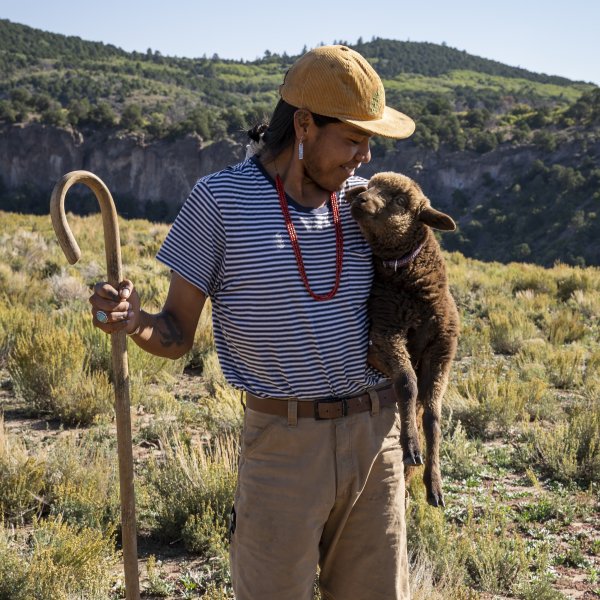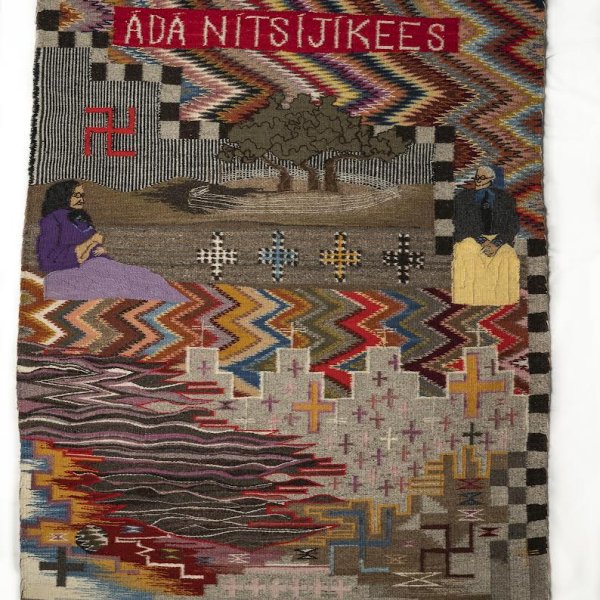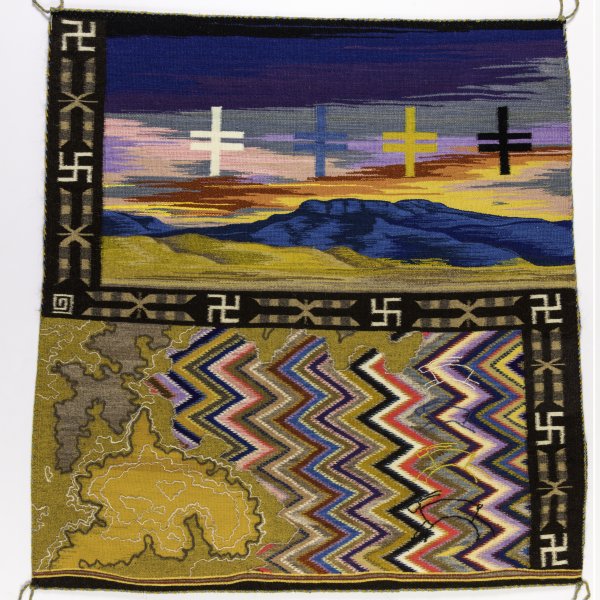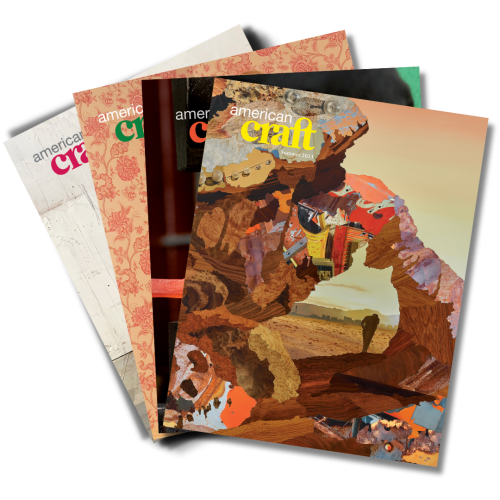The Queue: Tyrrell Tapaha
Get to know the people featured in the pages of our magazine as they share what's inspiring them right now.
Tyrrell Tapaha weaves Diné lifeways and modern vignettes into vivid, challenging works.
Sixth-generation Diné weaver and sheepherder Tyrrell Tapaha weaves colorful textiles rich with tradition and innovation, combining the legacy and influence of their family’s art with abstraction and contemporary imagery. Tapaha grew up in the Carrizo Mountains of northeastern Arizona, tending to their family’s flock of Navajo-Churro sheep, carding and spinning wool, and absorbing pastoral and artistic knowledge from relatives. Their work is grounded in the ecology of the mountains: they use local plant dyes to color wool and fleece, which they harvest from sheep they raise from birth. “I’ve really taken to holding myself responsible to understand the methodologies of how my people got here,” they say. They are currently working on a series of large-scale works showing figurative images of sheepherding, in advance of the Santa Fe Indian Market (August 19–20) and a group show at James Fuentes Gallery (September 8–October 15). Roshii Montaño wrote about Tapaha and their work in “Dazzling Pictorials” in the Summer 2023 issue of American Craft.

Tyrrell Tapaha with their lamb, Chloe, at the family summer camp in Arizona’s Carrizo Mountains. Photo courtesy of Dawson Peters.
How do you describe your work or practice?
I’m a sixth-generation Diné weaver and fiber artist. My work encapsulates agro-pastoral living and understanding the inner workings of doing everything sheep-to-loom: being on the land, working with the land, ecology, hydrology, migrating, grazing the animals, and thinking about and breeding for better fleece. I spend a lot of time looking at the minuscule and larger details of this lifestyle, and my weavings are a glimpse of that.
What is your design process when you start a new weaving project?
It depends. I’ve been working on a larger series of specifically sheepherding-pertinent works, and there’s a set imagery and style that I’m going for. I really like using a lot of older techniques and amalgamations of older techniques that haven’t really been done in the past. I either have an idea in my head, do a vague sketch-out just to keep a reminder, and then put it on the loom; or, in some cases—which I think is more enjoyable—I kind of just let it free-flow. You can see that in a lot of my work: they seem very amorphous and fluid, there’s no consistent design throughout the work. At least for my eye and my interest as a weaver, that’s always just been way more interesting and entertaining than doing something ornately beautiful and symmetrical.

Think for Yourself, 2022, handspun and commercial vegetal-dyed Navajo-Churro and alpaca, 61 x 42 in. Photo courtesy of Dawson Peters.

Just a Sheepherder, 2022, handspun and vegetal-dyed Navajo-Churro and alpaca, 46 x 48 in. Photo by Alon Koppel.
What are your favorite tools in your tool kit, and how do you use them?
I’ve been very blessed to have inherited a lot of my tools made by my great-grandma or her parents. Recently I’ve delved into making my own tools. Right now my favorite tools are my two larger battens that I got from my great-grandma; she carved those a while ago. They are beautiful and have served me well and have been a part of every one of my larger works. [Another favorite] is the comb that I made for myself. I think it’s really important for makers to understand what it takes to make the tools that we have and be able to consistently implement and season them as we go.
If you could have work from any contemporary weaver for your home/studio, whose would it be and why?
A huge person in my life and also a friend is Erin M. Riley, based in Brooklyn. She does phenomenal work, not only on a technical level but in the vulnerability of her message. Fiber is inherently personal. It’s a glimpse of our humanity. It’s a way of documenting, working with, and even wearing our humanity. I draw a lot of inspiration from her work—she’s one of the heavy hitters.
Do you listen to music, podcasts, radio, or audiobooks while you weave or work with sheep? If so, what has stuck with you lately?
I’m a music-heavy person. My friend group is comprised of artists, makers, craftspeople, and musicians. I listen to a lot of old-time music, like bluegrass. It just has a drive that can’t really be replicated. It is just classic, old-sounding music about heartbreak, love, partying, and substance abuse, and it speaks to the soul. For how personal my work is, that’s just a really good powerhouse that gets me going and can get me in a groove.
Which craft artists, exhibitions, or projects do you think the world should know about, and why?
Shaped by the Loom: Weaving Worlds in the American Southwest at Bard Graduate Center in New York City, curated by Hadley Jensen. I served as a cultural advisor and wrote object labels for this [recent] exhibition. It was really refreshing to see never-before-seen textiles from private collections, specifically Navajo textiles, shown in the city that brought about the commercialization of Navajo weaving. The exhibition also featured personal messages about what the work means through our eyes as weavers and as sheepherders.
Another one that stands out to me is Horizons: Weaving Between the Lines with Diné Textiles (July 16, 2023–June 2, 2024) at the Museum of Indian Arts and Culture in Santa Fe. I served as a board member for the exhibition and contributed a lot to it, and I have a couple of my own works in it. This show is really unique in the sense that it’s the first-ever exhibition of its kind that has been curated by weavers for weavers.

Learn more about the artists you love by becoming a member today!
Become a member to get a subscription to American Craft magazine and experience the work of artists who are defining the craft movement today.




